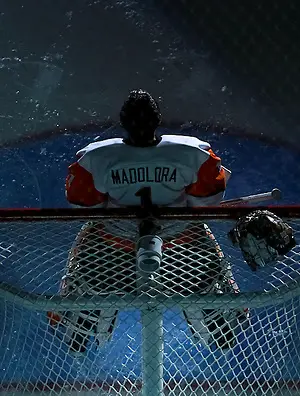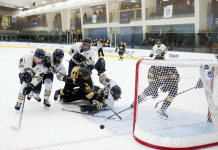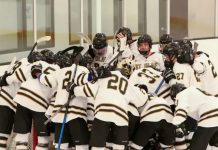After a summer of uncertainty and tragedy in the hockey world, it’s good to be able to finally focus on what’s happening on the ice.
The deaths of three NHL players as well as the Locomotiv plane crash disaster cast a pall over all of hockey. And while college hockey was spared that kind of human tragedy, the upheaval caused by the formations of the Big Ten and the National Collegiate Hockey Conference initiated a mad game of musical chairs for dozens of teams. And it hasn’t sorted itself out yet.
So far, Atlantic Hockey remains untouched, but some programs were and still are ready to jump ship should the right offer come along. The CCHA teams that remained after the Big Ten and NCHC poached half of the league’s membership met with Niagara, Canisius, Robert Morris and Mercyhurst over the summer and also approached Air Force and Rochester Institute of Technology. The latter schools declined to meet.
“We’re flattered to have been contacted, but we’re happy where we’re at,” said RIT coach Wayne Wilson.
In the end, all but two of the remaining CCHA schools joined the orphans left in the WCHA, leaving only Notre Dame, which most likely will wind up in Hockey East, and Bowling Green, which has to either join the WCHA or get creative. That’s where Atlantic Hockey is back in the mix.
Those same teams that the CCHA was interested in have been contacted by Bowling Green, and some are listening. And, despite what Air Force coach Frank Serratore has said about the Falcons not leaving, news reports indicate that a move to the new WCHA has not been ruled out. Serratore says he wants to be left out of the discussion.
“I don’t want to be a part of the rumors and burn positive energy trying to figure and manipulate someplace better to be,” he said.
And don’t leave RIT out of the mix just yet. As happy as the Tigers are in Atlantic Hockey, the school would seriously consider a move to ECAC Hockey if a spot opened up. And one may if Notre Dame moves to Hockey East as anticipated, because that league would probably then add a 12th team, most likely Rensselaer or Quinnipiac. That would leave an open ECAC spot, and RIT could be interested.

That’s a lot for fans to take in, but for the time being the only big change in Atlantic Hockey that’s actually happening is a revamped playoff format, the ninth different postseason format in the nine years the AHA has existed. This one could be argued to be the best the league has ever had, and one hopes that 12 teams stick around so it can be used for years to come.
After the largely unpopular “pod” standings-within-standings yielded some unfair postseason matchups, the league has kept the unbalanced schedule but has gone to seedings based on the actual standings, as well as instituting a best-of-three format for the first two rounds of the playoffs.
“I think the new format is going to further enhance the competitiveness of the league, and it will certainly place more importance on the regular season schedule and where teams finish in the standings,” said AHA commissioner Bob DeGregorio.
The league is riding the momentum of another season that saw the caliber of play improve, as evidenced by 11 former players in NHL preseason camps, buy far the most ever. The AHA champion again was a team to be reckoned with in the NCAA tournament, with Air Force taking top-seeded Yale to overtime before falling 2-1.
Plenty of talent has left Atlantic Hockey, as evidenced by those NHL camps. Seven of those 11 players were in the AHA just last season. But according to the coaches, the overall impact is balanced across the league, with the preseason poll looking a lot like the final standings.
That means improving teams like Connecticut are expected to continue to get better, but not enough to knock off perennial front-runners Air Force and RIT. The Falcons have won four of the last five playoff titles, and the Tigers have four of the last five regular season crowns.
“I think [there was little movement in the preseason poll] because while a lot of teams lost some key players, every team still has a lot left and there are some really strong freshman classes,” said Wilson. “We’ll really know once the season gets started, but for now, I know that I don’t think I voted any team more than one or two places from where they finished last year.”
Just because the coaches expect the status quo doesn’t mean there won’t be plenty of drama in store:
• In past seasons, there has been a team that has exceeded expectations, like Connecticut last season and Sacred Heart the year before. There’s also usually a team or two that falls short of the mark, like the Pioneers last year. Who’s the team most likely to move in the standings one way or another? It could be a downturn for Mercyhurst, which lost 65 percent of its scoring and its starting goaltender. Sacred Heart could rebound and move up if it can find consistent goaltending.
• RIT and Air Force have been the leaders since moving into the league six years ago, but each team goes about it differently. The Falcons are a streaky team, and usually are playing their best hockey at the end of the season. The Tigers do it with consistency, taking at least a point on virtually every weekend. Can both teams keep it up? Chances are you’ll again find these schools at the top of the standings once the dust settles.
• Niagara and Robert Morris made a splash in their first year in the league, in no small part due to a dynamic duo on each team. The Purple Eagles’ Bryan Haczyk and Paul Zanette as well as the Colonials’ Denny Urban and Nathan Longpre were four of the best players in the league. But all four have moved on. Both teams will need others to step up so they don’t step down in the standings.
• Last year the West “pod” dominated the early part of they season, but Holy Cross and UConn came on strong and both made it to Rochester. Neither team suffered heavy losses due to graduation. Can the East turn the tables and produce a champion this season? Holy Cross has a real shot and is deserving of the first-place votes it got in the preseason poll.
• Last season was the best for Canisius in the Dave Smith era, with the Golden Griffins improving each year as their talented class of 2011 gained more experience and confidence. Now Cory Conacher and company are gone, and the Griffs have 12 rookies on the roster. Will they take a step back? Chances are yes, this will be a rebuilding year, but not as much as some might think. Success breeds more success.
• American International, Army and Bentley finished in the bottom half of the standings. Which team has the best chance of breaking out? It could be Army with its large senior class.
Here are my picks for the final standings in Atlantic Hockey for the 2011-12 season. Click on each team for a more detailed preview:
1. Air Force
2. Rochester Institute of Technology
3. Holy Cross
4. Niagara
5. Connecticut
6. Robert Morris
7. Canisius
8. Mercyhurst
9. Army
10. Sacred Heart
11. Bentley
12. American International


